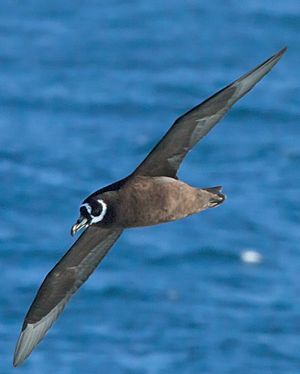Spectacled petrel facts for kids
Quick facts for kids Spectacled petrel |
|
|---|---|
 |
|
| Conservation status | |
| Scientific classification | |
| Genus: |
Procellaria
|
| Species: |
conspicillata
|
| Synonyms | |
|
Procellaria aequinoctialis conspicillata |
|
The spectacled petrel (Procellaria conspicillata) is a special type of seabird. It's quite rare and only builds its nests on Inaccessible Island. This island is part of the Tristan da Cunha group in the South Atlantic Ocean. It's also one of the biggest petrels that digs burrows to live in.
Contents
About the Spectacled Petrel
The spectacled petrel is a large bird, about 55 cm (22 in) long. It is mostly black. This bird has cool white rings around its eyes, like spectacles! Its bill is bright yellow. On average, these petrels can live for about 26 years.
Petrel Family and Features
The spectacled petrel belongs to a group of birds called Procellaria. It is part of the family called Procellariidae. All birds in this family have some unique features.
First, they have special nasal passages on their upper bill. These are called naricorns. The nostrils on a petrel are right on top of its bill.
Second, petrels can make a special "stomach oil." This oil is stored in their stomach. They can spray it out of their mouths if a predator tries to attack them. This oil is also a super-rich food source. Parents feed it to their chicks. It also helps adult birds get energy during their long flights.
Finally, petrels have a salt gland above their nose. This gland helps them get rid of extra salt from their bodies. They drink a lot of ocean water, so this gland is very important. It lets out a salty liquid from their nose.
For a long time, the spectacled petrel was thought to be the same species as the white-chinned petrel. Or, people thought it was just a different color version of that bird. But in 2004, scientists at BirdLife International decided they were two separate species.
What's in a Name?
The name Procellaria comes from two Latin words. Procella means "a storm," and arius means "pertaining to." This name was given because these birds are often seen during stormy weather.
The word petrel comes from St. Peter. There's a story about him walking on water. Petrels look like they are running on the water when they take off to fly. That's how they got their name!
How Spectacled Petrels Live
What They Eat
Spectacled petrels eat different kinds of sea creatures. They enjoy eating squid and octopus, fish, and crabs and shrimp.
Reproduction and Nests
These petrels breed every year. They lay one egg in their nest. Their nests are burrows dug into the ground. They build these burrows along riverbanks and in marshy areas. They like to nest in wet, open land above 380 m (1,250 ft) high.
Where They Live and Travel
Spectacled petrels are oceanic birds. This means they spend most of their lives far out at sea. When it's not breeding season, many of them are found off the coast of southern Brazil. They also travel east to the west coast of southern Africa. In the past, they might have lived all over the southern Indian Ocean.
During breeding season, they return to Inaccessible Island. This island is part of the Tristan da Cunha group. They probably used to breed on Amsterdam Island too.
Protecting the Spectacled Petrel
The spectacled petrel is a vulnerable species. This means it needs our help to survive. In 2000, it was listed as critically endangered. This is the highest risk level. But later studies gave hope. The number of birds was slowly going up from a very low point in the 1930s.
It's hard to count these birds because their island home is very rugged. So, their numbers might have been higher than thought. Because of this, their status was changed to vulnerable in 2007. This is still a serious concern, but it's a step up from critically endangered.
There are between 31,000 and 45,000 spectacled petrels in the world. Their population is slowly growing.
The biggest threat to these petrels is longline fisheries. Hundreds of birds die each year when they get caught in fishing lines and drown. Other dangers come from animals like wild pigs and black rats. These animals can harm the birds or their eggs.
Many groups are working to protect the spectacled petrel. Inaccessible Island is a World Heritage Site. This means it's a special place that is protected. Access to the island is limited to keep the birds safe.
Other ways to help include:
- Counting the breeding population regularly.
- Encouraging fisheries to use safer methods to avoid catching birds. Organizations like the Food and Agriculture Organization and Agreement on the Conservation of Albatrosses and Petrels are working on this.
- Stopping new animals from being brought to the island. This helps prevent new threats.
- Looking for other safe places where these birds could breed.
See also
 In Spanish: Pardela de anteojos para niños
In Spanish: Pardela de anteojos para niños


